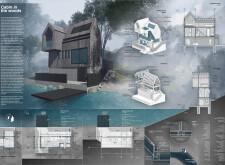5 key facts about this project
The Cabin in the Woods is a microhome that sits along the West Morava river near Čačak, surrounded by thick forest. The design focuses on sustainability and functionality while blending into the natural landscape. Simple and efficient, the layout aims to meet the needs of its residents while adapting to the local climate, which features cold winters and hot, humid summers.
Orientation and Layout
The cabin is carefully positioned to take advantage of natural light and views of the river to the south. This orientation enhances the internal atmosphere and helps with passive heating and cooling. The structure consists of three levels: a basement, a first floor designed for daily living, and a smaller top floor for sleeping. Public and private spaces are clearly defined, creating an effective flow within the home.
Sustainability Features
One important design choice is the elevation above ground level, which counters potential flooding from the nearby river. This elevation allows for essential utilities, including a septic tank, biodigester, hot water boiler, and battery storage, to be housed safely beneath the cabin. The use of a mini hydro plant and solar panels supports the home’s energy needs, emphasizing its self-sufficiency and reducing the need for external power sources.
Material Optimization
Wooden prefabricated panels form the main structure, chosen for their suitability to the climate. The elevated foundation is made from green concrete, which is produced using waste materials, showcasing an environmentally conscious method of construction. The cabin incorporates triple-glazed windows acquired from previous projects, enhancing insulation and comfort. Mineral wool insulation further contributes to maintaining a stable indoor environment. Recycled wood is used throughout the home, emphasizing resource efficiency and sustainable practices.
The design also features clever storage spaces, including areas under the stairs, which maximize utility without sacrificing comfort. Attention to detail in both functionality and aesthetics creates an inviting atmosphere that remains connected to the surrounding woods.



















































